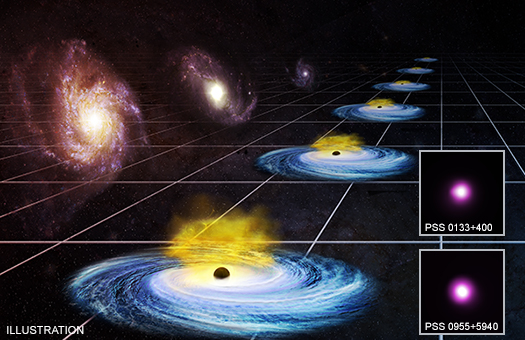For Release: January 29, 2019
NASA/CXC

Credit: Illustration: NASA/CXC/M.Weiss; X-ray: NASA/CXC/Univ. of Florence/G.Risaliti & E.Lusso
Press Image, Caption, and Videos
Astronomers have found evidence that an invisible force called dark energy, widely thought to be constant, may be getting stronger with time. If confirmed, this result could force astronomers to re-examine their fundamental understanding of the history and structure of the Universe.
This new study uses X-ray data from NASA's Chandra X-ray Observatory and ESA's XMM-Newton along with ultraviolet (UV) data from the Sloan Digital Sky Survey (SDSS).
First discovered about 20 years ago by measuring the distances to exploding stars called supernovas, dark energy is a proposed type of force, or energy, that permeates all space and causes the expansion of the Universe to accelerate. It accounts for about 70 percent of the composition of the Universe. In the "concordance model," currently used in most studies of the history and structure of the Universe, dark energy is interpreted as the "cosmological constant." That means it is energy associated with empty space, and is constant throughout space and time.
The crux of the latest result is the development of a new method to determine distances to quasars, rapidly growing black holes in the distant Universe that shine extremely brightly. This method, which used data on about 1,600 quasars, allows astronomers to determine distances to quasars that are much farther away from Earth than the observed supernovas.
Using these quasar distances, Guido Risalti of the University of Florence in Italy, and Elisabeta Lusso of Durham University in the United Kingdom, extended calculations of the expansion rate of the Universe to greater distances and hence earlier times in the evolution of the Universe. XMM-Newton revealed quasars back to times when the Universe was only 2.3 billion years old, and Chandra and XMM detected quasars back to ages between 1.1 billion and 2.3 years. (The currently accepted age of the Universe itself is 13.8 billion years old.)
As reported in the latest issue of Nature Astronomy, they found an expansion rate different from the predictions of the concordance model.
"We observed quasars back to just a billion years after the Big Bang, and found that the Universe's expansion rate up to the present day was faster than we expected," said Risaliti. "This could mean dark energy is getting stronger as the cosmos grows older."
The new technique uses UV and X-ray data from these quasars to estimate their distances.
In quasars, a disk of matter around the black hole produces UV light. Some of the UV light collides with electrons in a cloud of hot gas above and below the disk, and these collisions can boost the energy of the UV light up to X-ray energies. This interaction causes a correlation between the amounts of observed UV and X-ray radiation. The distance to the quasar depends on this correlation.
Risaliti and Lusso compiled UV data from SDSS and X-ray data from Chandra and XMM for 1,598 quasars to derive a relationship between UV and X-ray fluxes, and the distances to the quasars. They then used this information to study the expansion rate of the universe back to very early times. They found evidence that the amount of dark energy is growing with time.
"Since this is a new technique, we took extra steps to show that this method gives us reliable results," said Lusso. "We showed that results from our technique match up with those from supernova measurements over the last 9 billion years, giving us confidence that our results are reliable at even earlier times."
The researchers also took great care in how their quasars were selected, to minimize statistical errors and to avoid systematic errors that might depend on the distance from Earth to the object.
If confirmed, this result would imply that dark energy is not the cosmological constant. It could also help resolve an ongoing mismatch between the measurement of the Hubble constant — the rate of expansion of the Universe — based on local indicators and the measurement based on the Cosmic Microwave Background (CMB).
Using supernova observations, astronomers had previously reported that the Universe appears to be expanding faster now than was expected from its trajectory seen shortly after the big bang, when the CMB was produced.
"Some scientists suggested that new physics might be needed to explain this discrepancy, including the possibility that dark energy is growing in strength," said Risaliti. "Our new results agree with this suggestion."
In order to further test these results, Risaliti and Lusso plan to use a large sample of Chandra observations of quasars at a wide range of distances and apply this same technique.
A preprint of the paper by Risaliti and Lusso is available on the arXiv.
NASA's Marshall Space Flight Center in Huntsville, Alabama, manages the Chandra program for NASA's Science Mission Directorate in Washington. The Smithsonian Astrophysical Observatory in Cambridge, Massachusetts, controls Chandra's science and flight operations.
Other materials about the findings are available at:
http://chandra.si.edu
For more Chandra images, multimedia and related materials, visit:
http://www.nasa.gov/chandra
Media contacts:
Megan Watzke
Chandra X-ray Center, Cambridge, Mass.
617-496-7998
mwatzke@cfa.harvard.edu


